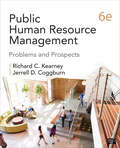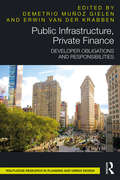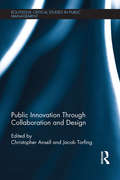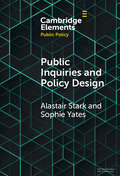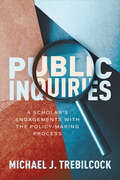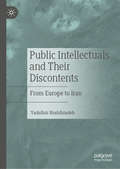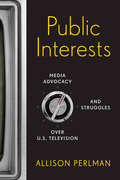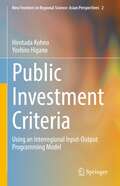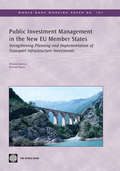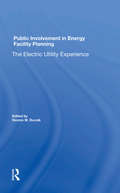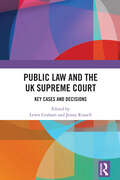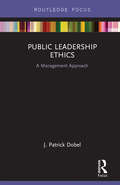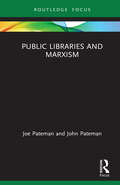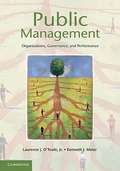- Table View
- List View
Public Human Resource Management: Problems and Prospects
by Richard C. Kearney Jerrell D. CoggburnPublic Human Resource Management: Problems and Prospects brings together exemplary contributors who provide concise essays on major contemporary public human resources management issues. Organized into four parts – setting, techniques, issues and prospects – and covering the major process, function and policy issues in the field, the text offers valuable wisdom to students and practitioners alike. With sixteen new and eleven updated chapters authored by the leading figures in the field as well as by up-and-coming new scholars, the new edition works as a primary or supplementary text for courses in human resource management or issues in public administration.
Public Human Resource Management: Strategies and Practices in the 21st Century
by Randy Paul BattaglioPublic Human Resource Management: Strategies and Practices in the 21st Century offers a novel take on public human resource management (PHRM) by providing practical guidance for practitioners operating in a drastically reformed HR environment. A comprehensive introduction to contemporary public HR management, this text incorporates analysis of the impact of the private sector-oriented reforms over the last few decades that have aimed to bring greater efficiency and productivity to the public sector. Reviewing foundational topics like recruitment and retention, pay and benefits, equal employment opportunity, and performance appraisal in light of five key reforms (decentralization, deregulation, declassification, privatization, and performance-based pay), author R. Paul Battaglio assesses how the traditional practice of public HR has changed—and not necessarily for the better. New material on human resource information systems, managing motivation in the public sector, and public HR management education is included — a topic rarely found in contemporary PHRM texts. Public Human Resource Management is an essential guide to public HR management and navigating the challenges and opportunities posed in the changing landscape of HR reform.
Public Infrastructure, Private Finance: Developer Obligations and Responsibilities
by Demetrio Muñoz Gielen Erwin Van Der KrabbenTraditionally, the public sector has been responsible for the provision of all public goods necessary to support sustainable urban development, including public infrastructure such as roads, parks, social facilities, climate mitigation and adaptation, and affordable housing. With the shift in recent years towards public infrastructure being financed by private stakeholders, the demand for transparent guidance to ensure accountability for the responsibilities held by developers has risen. Within planning practice and urban development, the shift towards private financing of public infrastructure has translated into new tools being implemented to provide joint responsibility for upholding requirements. Developer obligations are contributions made by property developers and landowners towards public infrastructure in exchange for decisions on land-use regulations which increase the economic value of their land. This book presents insight into the design and practical results of these obligations in different countries and their effects on municipal financial health, demonstrating the increasing importance of efficient bargaining processes and the institutional design of developer obligations in modern urban planning. Primarily written for academics in land-use planning, real estate, urban development, law, and economics, it will additionally be useful to policy makers and practitioners pursuing the improvement of public infrastructure financing.
Public Innovation through Collaboration and Design (Routledge Critical Studies in Public Management)
by Jacob Torfing Christopher AnsellWhile innovation has long been a major topic of research and scholarly interest for the private sector, it is still an emerging theme in the field of public management. While ‘results-oriented’ public management may be here to stay, scholars and practitioners are now shifting their attention to the process of management and to how the public sector can create ‘value’. One of the urgent needs addressed by this book is a better specification of the institutional and political requirements for sustaining a robust vision of public innovation, through the key dimensions of collaboration, creative problem-solving, and design. This book brings together empirical studies drawn from Europe, the USA and the antipodes to show how these dimensions are important features of public sector innovation in many Western democracies with different conditions and traditions. This volume provides insights for practitioners who are interested in developing an innovation strategy for their city, agency, or administration and will be essential reading for scholars, practitioners and students in the field of public policy and public administration.
Public Inquiries and Policy Design (Elements in Public Policy)
by Alastair Stark Sophie YatesPublic inquiries regularly produce outcomes of importance to policy design. However, the policy design literature has largely ignored the many important ways that public inquiries can act as policy design tools, meaning the functions that inquiries can offer the policy designer are not properly understood. This Element addresses this gap in two ways. First, it presents a theoretical discussion, underpinned by international empirical illustrations, to explain how inquiries perform policy design roles and can be classified as procedural policy tools. It focuses on four inquiry functions – catalytic, learning, processual, and legitimation. Second, it addresses the challenge of designing inquiries that have the policy-facing capacities required to make them effective. It introduces plurality as a key variable influencing effectiveness, demonstrating its relevance to internal inquiry operations, the external inquiry environment, and policy tool selection. Thus, it combines conceptual and practical insights to speak to academic and practice orientated audiences.
Public Inquiries: A Scholar’s Engagements with the Policy-Making Process (UTP Insights)
by Michael J. TrebilcockAn internationally renowned scholar of law and economics, Michael J. Trebilcock has spent over fifty years teaching and researching at the intersection between ideas, interests, and institutions. In Public Inquiries, Trebilcock reflects on his extensive experiences and sheds light on the role of scholars in engaging with the Canadian public policy-making process. Drawing on a number of case studies, Public Inquiries gives an informed overview of the role of ideas and interests in shaping the policy-making process. Trebilcock takes readers through his personal experiences and what he has learned throughout his career. He puts forward general lessons about the public policy-making process and reform in areas including consumer protection, competition policy, trade policy, electricity reform, and legal aid. By showing that not all experiences have been triumphant, and that disappointments can be as revealing as successes, Trebilcock draws out personal lessons and insights with a view to improving the structure and effectiveness of public inquiries.
Public Intellectuals and Their Discontents: From Europe to Iran
by Yadullah ShahibzadehThis book addresses the ways in which the figure of the intellectuals and their relationship to the public has been theorized through the conceptualizations of bureaucracy, democracy, and communism as universal processes from the 19th century to the present. Starting with Hegel and Marx, the author looks at the rise of the figure of the universal intellectual in various forms, before turning to what is presented as a transformation of the figure of the intellectual into ‘the public intellectual’ advanced by the New Philosophies and the critical response offered by Edward Said. The study presents two comparative case studies: the Iranian Revolution and the public intellectuals in Europe, specifically in Norway, before concluding with a focus on the decay of the figure of the intellectuals and highlighting Ranciere’s critique of the intellectual/masses distinction.
Public Interest Litigation in Asia (Routledge Law in Asia)
by Po Jen YapThis edited volume is a timely and insightful contribution to the growing discourses on public law in Asia. Surveying many important jurisdictions in Asia including mainland China, Hong Kong, India, Malaysia, Singapore, South Korea and Taiwan, the book addresses recent developments and experiences in the field of public interest litigation. The book offers a comparative perspective on public law, asking crucial questions about the role of the state and how private citizens around Asia have increasingly used the forms, procedures and substance of public law to advance public and political aims. In addition to addressing specific jurisdictions in Asia, the book includes a helpful and introduction that highlights regional trends in Asia. In the jurisdictions profiled, transnational public interest litigation trends have commingled with local dynamics. This volume sheds light on how that commingling has produced both legal developments that cut across Asian jurisdictions as well as developments that are unique to each of the jurisdictions studied.
Public Interests: Media Advocacy and Struggles over U.S. Television
by Allison PerlmanNearly as soon as television began to enter American homes in the late 1940s, social activists recognized that it was a powerful tool for shaping the nation's views. By targeting broadcast regulations and laws, both liberal and conservative activist groups have sought to influence what America sees on the small screen. Public Interests describes the impressive battles that these media activists fought and charts how they tried to change the face of American television. Allison Perlman looks behind the scenes to track the strategies employed by several key groups of media reformers, from civil rights organizations like the NAACP to conservative groups like the Parents Television Council. While some of these campaigns were designed to improve the representation of certain marginalized groups in television programming, as Perlman reveals, they all strove for more systemic reforms, from early efforts to create educational channels to more recent attempts to preserve a space for Spanish-language broadcasting. Public Interests fills in a key piece of the history of American social reform movements, revealing pressure groups' deep investments in influencing both television programming and broadcasting policy. Vividly illustrating the resilience, flexibility, and diversity of media activist campaigns from the 1950s onward, the book offers valuable lessons that can be applied to current battles over the airwaves.
Public Investment Criteria: Using an Interregional Input-Output Programming Model (New Frontiers in Regional Science: Asian Perspectives #2)
by Hirotada Kohno Yoshiro HiganoThis volume presents the most robust and useful methodology for the derivation of investment criteria for the evaluation and planning of public investment projects – public investment criteria. The methodological approach solves inherent defects of traditional methodology, namely an ad hoc application of the benefit-cost analysis in the static content.Although this approach originated in the water resources development project of the Harvard group, the authors’ methodology has achieved a discrete and dynamic inter regional input-output programming model by which: (i) establishment of priorities among potential investment targets by taking account of economic benefits that are brought by implementation of a set of selected projects, and diffusing into the whole national economy, and (ii) rational allocation of limited public funds to the selected investment projects are consistently made, based on the opportunity cost criteria in the dynamic content. As these benefits make up a source for the stream of further created capital funds for public as well as private sectors over the planning time horizon, optimal re-investment of thus created capital funds are solved recursively in the endogenous model by approaching the turnpike path of the whole national economy. As an optimal solution, the allocated levels for trunk expressway network as well as for other transport facilities, which are balanced with the allocation for industrial capital formation, are obtained by period and by region. In the background of these processes, the imputed price and opportunity costs as a sort of contemporary “god” are always latent.Readers with basic mathematical knowledge will learn functional and practical meaning of the opportunity costs (and the imputed price) in the evaluation and planning of investment. Conquering this small obstacle will be a source of strong self-confidence for society, a worthwhile objective. Other applications of the methodology are also included in this book, which is helpful for practitioners frequently using the feasibility study method as well as experts who wish to understand the theoretical arguments related to public investment criteria. As one of the applications, there is a numerical solution of a composite transport system in which the amounts of roads, railways, and ports are derived quantitatively, not qualitatively. These are results of authentic public investment criteria that are built in the inter-regional input-output programing model.
Public Investment Management in the New EU Member States
by Thomas Laursen Bernard MyersThis paper describes the characteristics of public investment management (PIM) in seven EU countries as it applies to a single sector-transport infrastructure. The report highlights some of the common challenges that four relatively new EU member states-Poland, Slovakia, Slovenia, and Latvia-face as they plan and execute their transport infrastructure projects. It recognizes the importance that EU-mandated processes and procedures have in shaping national systems in the new member states (NMS), but the report finds that actual practices often fall short of EU goals due to capacity constraints, weak institutional structures, and other factors. The experiences of the NMS are compared with those of more developed economies (namely Spain, the UK, and Ireland) to assess whether the later countries have faced similar challenges in managing public investment, and if so, what measures they have adopted to overcome them. This comparative analysis serves to draw out several good practice examples that are relevant for all countries. How those practices are applied in each country is a matter for further study, as each country considers its own political culture and administrative tradition. This paper is a first step toward building dialogue among public finance practitioners in Central and Eastern Europe on how to make public investment projects more effective and efficient over the long term.
Public Investment and Public-Private Partnerships
by Gerd Schwartz Richard Hemming Bernardin AkitobyThere are now increasing concerns about the need to upgrade public infrastructure, improve the delivery of public services, and explore new options for partnering with the private sector. This book looks at& ways of strengthening the efficiency of public investment and managing the fiscal risks of& public-private partnerships.
Public Investment and Public-Private Partnerships: Addressing Infrastructure Challenges and Managing Fiscal Risks
by Gerd Schwartz Ana Corbacho Katja FunkeThere are now increasing concerns about the need to upgrade public infrastructure, improve the delivery of public services, and explore new options for partnering with the private sector. This book looks at& ways of strengthening the efficiency of public investment and managing the fiscal risks of& public-private partnerships.
Public Involvement In Energy Facility Planning: The Electric Utility Experience
by Dennis W DucsikBecause the power industry is anticipating greatly increased generating capacity requirements in the 1990s, political controversy over electricity demand and supply is likely to return to--and perhaps surpass--the level of rancor experienced during the 1970s. Fortunately, a sizable number of utility companies have come to believe that destructive c
Public Justice and the Anthropology of Law
by Ronald Niezen"In this powerful, timely study Ronald Niezen examines the processes by which cultural concepts are conceived and collective rights are defended in international law. Niezen argues that cultivating support on behalf of those experiencing human rights violations often calls for strategic representations of injustice and suffering to distant audiences. The positive impulse behind public responses to political abuse can be found in the satisfaction of justice done. But the fact that oppressed peoples and their supporters from around the world are competing for public attention is actually a profound source of global difference, stemming from differential capacities to appeal to a remote, unknown public. Niezen's discussion of the impact of public opinion on law provides fresh insights into the importance of legally-constructed identity and the changing pathways through which it is being shaped - crucial issues for all those with an interest in anthropology, politics and human rights law"--
Public Knowledge And Environmental Politics In Japan And The United States
by John C Pierce Nicholas P Lovrich Taketsugu Tsurutani Takematsu AbeThis book grows out of the authors' conviction that as public policy issues become suffused with scientific and technical content, they become difficult for the democratic citizens to understand. It attempts to determine mass public capacity and their motivation to respond to the challenges.
Public Lands And The U.s. Economy: Balancing Conservation And Development
by Peter Emerson George M JohnstonCurrent law requires the federal government to fulfill a broad spectrum of responsibilities in managing public lands; to protect and conserve the environment; to foster the appropriate development of marketable commodities; to preserve wilderness areas, wildlife habitats, and unique historical sites; and to encourage public participation in land-use and management decisions. There is no consensus, however, on the best ways to establish a balance among the? priorities when serious conflicts arise. This book presents a wide-ranging discussion of the means by which lands and resources administered by the Forest Service and the Bureau of Land Management can better serve present and future needs for environmental preservation and resource development. The contributors consider public and private interests in the federal lands in light of political realities and uncertainties, giving particular: attention to efficiency-versus-equity issues, privatization fair market value, and the income-producing potential of publicly owned assets. Major sections of the book focus on timber, nonfuel minerals, rangelands, and energy resources. Based on a recent conference sponsored by The Wilderness Society, the book reflects the views of conservationists, scholars, industry representatives, and state and federal officials.
Public Lands and Political Meaning: Ranchers, the Government, and the Property Between Them
by Karen R. MerrillThe history behind the recurring "sagebrush rebellions" in the American West, showing how (before environmentalists entered the fray) ranchers and the feds struggled over the uses of public lands, from the days when ranchers wanted more government support to the virulent anti-federal position that remains.
Public Law and the UK Supreme Court: Key Cases and Decisions
by Lewis Graham Jenny RussellThis volume brings together expert commentators across different fields of public law to comment on key decisions by the UK Supreme Court (UKSC).Each author explores their case’s content, as well as its broader implications for public law as a field and the Supreme Court as an institution. The work is divided into the following areas: constitutional law, administrative law and judicial review, human rights, and criminal law and criminal justice. Providing expert commentary on recent authorities of the highest level in one place, the collection will enable readers interested in these areas to conveniently locate analysis that will aid them in their work. Taken together, the contributions enable identification of persistent themes within subject areas.As such, it will be an invaluable resource for academics, researchers, practitioners, judges, and policymakers.
Public Leadership Ethics: A Management Approach
by J. Patrick DobelDesigned to help midlevel and senior managers in organizations dedicated to public purposes, this book provides trained self-awareness to deploy values to guide decisions and build the culture of their organizations. The book explores how all managing involves leading and identifies the levels of ethical responsibility for managerial leaders. Highlighting the fundamental role that ethics plays in organizational life, J. Patrick Dobel uses insights from cognitive and social psychology to discuss how to anticipate and address threats to integrity and value informed decision making. Building on traditional ethical theory and modern research, the book begins with the fundamental assumption that individuals possess responsibility when they act for ethical purposes and results in taking a position within a public or nonprofit organization. This assumption of responsibility recognizes the inherent discretion in all positions and claims that effective ethical management requires self-awareness, self-mastery, integrity and a working frame of one’s values and character. The book pays special attention to the challenges of integrating diverse people and perspectives in public organizations as well as attending to the slippages to integrity in organizational life and how managers and leaders can foresee and address ethical slippage and corruption. The book provides checklists and decision frameworks that individuals can adopt and deploy to guide decisions. Public Leadership Ethics: A Management Approach will help create strong value informed cultures supported by communication, transparency, incentives and strong management cadres to achieve high quality service and integrity based actions. It will be of special interest to managerial leaders in public service and teaching in public administration and policy programs or executive training.
Public Libraries and Marxism
by John Pateman Joe PatemanPublic Libraries and Marxism provides a Marxist analytical framework for understanding public libraries and presents a set of proposals for transforming the capitalist libraries of today. Evaluating the strengths and weaknesses of this Marxist framework, the authors also provide a critical examination of the history, theory and practice of libraries in the Soviet Union and North Korea. Considering what a Marxist library service would look like in the Western capitalist countries of today, Pateman and Pateman synthesise the insights provided throughout the book into a set of Marxist proposals designed to promote the transformation of contemporary Western public librarianship. These proposals suggest how Western public libraries can change their organisation and practices – their strategies, structures, systems and culture – in order to best serve those with the most needs, particularly as society evolves in response to new challenges. Public Libraries and Marxism will be relevant for scholars and students of library and information science, history, politics and sociology. Outlining the rudiments of a Marxist library service that should be applicable around the world, the book will also appeal to library practitioners who want to develop libraries in a community-led and needs-based direction.
Public Man, Private Woman: Women in Social and Political Thought - Second Edition
by Jean Bethke ElshtainFocusing on the Western philosophical tradition and the work of contemporary feminists, Jean Elshtain explores the general tendency to assert the primacy of the public world—the political sphere dominated by men—and to denigrate the private world—the familial sphere dominated by women. She offers her own positive reconstruction of the public and the private in a feminist theory that reaffirms the importance of the family and envisions an "ethical polity."
Public Management
by Kenneth J. Meier Laurence J. O'Toole JrHow effective are public managers as they seek to influence how public organizations deliver policy results? How, and how much, is management related to the performance of public programs? What aspects of management can be distinguished? Can their separable contributions to performance be estimated? The fate of public policies in today's world lies in the hands of public organizations, which in turn are often intertwined with others in latticed patterns of governance. Collectively, these organizations are expected to generate performance in terms of policy outputs and outcomes. In this book, two award-winning researchers investigate the effectiveness of management in the public sector. Firstly, they develop a systematic theory on how effective public managers are in shaping policy results. The rest of the book then tests this theory against a wide range of evidence, including a data set of 1,000 public organizations.
Public Management
by Laurence J. O'Toole Jr. Kenneth J. MeierOffering much more than a purely theoretical or retrospective view of public management, this exciting text is an invaluable new addition to the field of public management. Putting the American model in perspective, it establishes the historical, theoretical, analytical, practical and future foundations for the comparative study of public management. Taking a boldly integrative approach, Laurence E. Lynn Jr. combines topics of best practice, performance, accountability and rule of law to provide a much-needed umbrella view of the topic. Well-written and illustrated with case study examples, this is one of the most exciting books on public management available today. As such it is an essential read for every student of public management, administration and public policy.
Public Management
by Konrad RaczkowskiPublic management is undoubtedly an acknowledged area of management science, but with meager empirical research. This book takes this challenge and presents a rare analysis of public management from the perspective of 12 Prime Ministers of Poland who governed between 1989 and 2014. The author features the concepts, practice and challenges of public management by making use of direct interviews with the Prime Ministers according to the classical management functions of planning, organization, direction and controlling. The book also presents a theoretical inquiry which redefines public management by breaking away from the traditional paradigm of public management, and introducing a 'mega-organizational' understanding of the state within new institutional economics.
